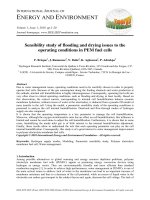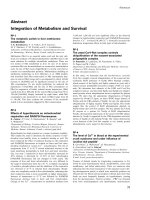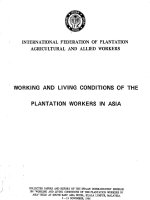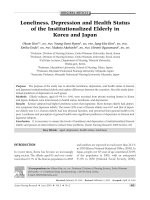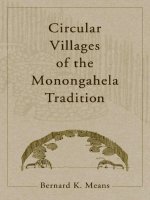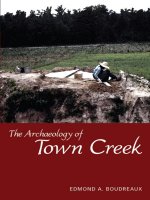university alabama press household chores and household choices theorizing the domestic sphere in historical archaeology jun 2004
Bạn đang xem bản rút gọn của tài liệu. Xem và tải ngay bản đầy đủ của tài liệu tại đây (2.71 MB, 330 trang )
HOUSEHOLD CHORES and
HOUSEHOLD CHOICES
HOUSEHOLD CHORES and
HOUSEHOLD CHOICES
Theorizing the Domestic Sphere in
Historical Archaeology
Edited by
KERRI S. BARILE and JAMIE C. BRANDON
THE UNIVERSITY OF ALABAMA PRESS
Tuscaloosa, Alabama
Copyright © 2004
The University of Alabama Press
Tuscaloosa, Alabama 35487–0380
All rights reserved
Manufactured in the United States of America
Typeface: Minion
∞
The paper on which this book is printed meets the minimum requirements of American
National Standard for Information Science–Permanence of Paper for Printed Library
Materials, ANSI Z39.48–1984.
Library of Congress Cataloging-in-Publication Data
Household chores and household choices : theorizing the domestic sphere in historical
archaeology / edited by Kerri S. Barile and Jamie C. Brandon.
p. cm.
Includes bibliographical references and index.
ISBN 0-8173-1395-8 (cloth : alk. paper) — ISBN 0-8173-5098-5 (pbk. : alk. paper)
1. United States—Antiquities. 2. Historic sites—United States. 3. Material culture—United
States. 4. Landscape—Social aspects—United States—History. 5. Households—United
States—History. 6. Family—United States—History. 7. Sex role—United States—History.
8. Archaeology and history—United States. 9. Feminist archaeology—United States.
10. Archaeology— Methodology. I. Barile, Kerri S. II. Brandon, Jamie C.
E159.5.H68 2004
640′.973—dc22
2004001019
Contents
List of Figures vii
List of Tables ix
Acknowledgments xi
Foreword (Maria Franklin) xiii
1. Introduction: Household Chores; or, the Chore of
De¤ning the Household 1
Jamie C. Brandon and Kerri S. Barile
PART I. A SENSE OF PLACE
2. Analysis of Household and Family at a Spanish Colonial
Rancho along the Rio Grande 15
Mindy Bonine
3. A Space of Our Own: Rede¤ning the Enslaved Household at
Andrew Jackson’s Hermitage Plantation 33
Whitney Battle
4. Separate Kitchens and Intimate Archaeology: Constructing
Urban Slavery on the Antebellum Cotton Frontier in Washington,
Arkansas 51
Leslie C. Stewart-Abernathy
5. “Living Symbols of their Lifelong Struggles”: In Search of the
Home and Household in the Heart of Freedman’s Town,
Dallas, Texas 75
James M. Davidson
PART II. A SENSE OF SPACE
6. Finding the Space Between Spatial Boundaries and Social
Dynamics: The Archaeology of Nested Households 109
Nesta Anderson
7. Hegemony within the Household; The Perspective from a South
Carolina Plantation 121
Kerri S. Barile
8. A Historic Pay-for-Housework Community Household:
The Cambridge Cooperative Housekeeping Society 138
Suzanne Spencer-Wood
9. Fictive Kin in the Mountains: The Paternalistic Metaphor and
Households in a California Logging Camp 159
Efstathios I. Pappas
PART III. A SENSE OF BEING
10. The Ethnohistory and Archaeology of Nuevo Santander
Rancho Households 179
Mary Jo Galindo
11. Reconstructing Domesticity and Segregating Households:
The Intersections of Gender and Race in the Postbellum
South 197
Jamie C. Brandon
12. Working-Class Households as Sites of Social Change 210
Margaret C. Wood
PART IV. MAKING SENSE OF IT ALL: COMMENTARIES ON
THE HOUSEHOLD
13. What Difference Does Feminist Theory Make in Researching
Households? A Commentary 235
Suzanne Spencer-Wood
14. Doing the Housework: New Approaches to the Archaeology
of Households 254
Mary C. Beaudry
References 263
Contributors 307
Index 309
vi / Contents
Figures
2.1. Map of Falcon Dam and Sites 41SR39 and 41SR43 19
2.2. Site 41SR39 20
2.3. Site 41SR43 21
2.4. Semirestored Galera Polychrome chocolatera vessel from
Site 41SR39 23
2.5. Close-up of Spanish 2 real, dated 1778, recovered from Feature 6
at Site 41SR43 25
3.1. Hermitage Plantation, general map 35
3.2. Image of First Hermitage Site 36
3.3. East Cabin, feature map 46
4.1. Schematic of plan of two-room kitchens, Washington, Arkansas 64
4.2. The Sanders kitchen as reconstructed in 1994 65
4.3. Detached kitchen behind the Page House, detail from a 1907
photograph 65
4.4. Kitchen placement on the Block and Sanders urban farmsteads 67
5.1. 1899 Sanborn Insurance Map of block of Juliette Street, Freedman’s
Town, Dallas 87
5.2. African-American cosmetic compact: “High Brown Face Powder”
(ca. 1911–1930) 103
7.1. Location of Middleburg Plantation and other sites discussed 125
7.2. Map of the current and historic cultural resources at Middleburg
Plantation 127
7.3. The southern and eastern elevations of the Commissary 129
8.1. 1870 Cambridge, Massachusetts, directory map showing approximate
locations of the CCHS cooperative and member households 147
9.1. Map of Soap Creek Pass, 1957 164
9.2. Plan drawing of three-man cabin at Soap Creek Pass 165
9.3. Plan drawing of a “T” family dwelling at Soap Creek Pass 166
9.4. Plan drawing of assistant superintendent’s dwelling at Soap
Creek Pass 168
9.5. Plan drawing of superintendent’s dwelling at Soap Creek Pass 170
10.1. Map of Nuevo Santander in the late eighteenth century illustrating
the ranchos of Mier and other communities on the north bank of the
Rio Grande 184
10.2. Part of the Juan Francisco Sáenz and Teresa Peña family 187
10.3. Part of the Miguel Sáenz and Gertrudis Hinojosa family 188
10.4. Map showing the porciones awarded in 1767 to the pobladores of Mier,
Tamaulipas, Mexico 189
10.5. Part of the Manuel Angel Hinojosa and Juana Sanchez family 192
10.6. Part of the Ramón Guerra and Rosalia Hinojosa family 193
12.1. Map of Colorado showing location of Berwind 216
12.2. Pie chart showing national origin of residents of Berwind 217
12.3. Map showing households in pre-strike locus 219
12.4. Bar graph showing number of households with and without
boarders 221
12.5. Pro¤le of midden feature 223
12.6. Bar graph showing increase in use of mass-produced canned goods in
strata dating after 1907 224
12.7. Bar graph showing plain ceramics by functional category 229
viii / Figures
Tables
3.1. Slave inventory from the Hermitage, 1846–1849 41
4.1. Slave ownership in Washington, Arkansas, 1850 and 1860 58
4.2. Slave demography in Washington, Arkansas, 1850 and 1860 59
5.1. 1900 Federal census enumeration for Juliette Street, Dallas, Texas
(abridged) 90
5.2. Estimated square footage of residences on Juliette Street 96
5.3. Juliette Street stability of residence, 1901–1910 98
10.1. Amount of livestock owned per ranch according to the 1817 census data
for Mier, Tamaulipas, Mexico 191
As editors, we would like to thank Maria Franklin and all our colleagues in her
graduate seminar in household archaeology at The University of Texas at Austin,
as well as all who participated in the symposium at the 2001 meeting of the
Society for Historical Archaeology in Long Beach, California, from which this
volume has grown. Not all who gave papers could contribute to this volume,
unfortunately, but all have in some way shaped our dialogue about households.
We would like to express our gratitude to Laurie Wilke and Amy Young, who
read early drafts of this volume and provided us with invaluable advice and
thought-provoking comments, and Mary Beaudry, for belatedly joining the
volume and adding her insightful contribution. Judy Goffman, our technical
editor, smoothed out all of the ¤nal wrinkles. Personally, we would like to
thank Sean and T.J.—for putting up with the weekends spent at work and the
“archaeology talk” at the dinner table.
Acknowledgments
The social unit that we refer to as the “household” has been the subject of
intensive study within anthropological archaeology, most notably since the
1970s, and particularly within prehistory (for example, Flannery 1976; Gero
and Conkey 1991; Wilk and Rathje 1982). For archaeologists, the household is
often the most basic social unit of analysis “accessible” through the archaeo-
logical record, typically via residential structures and activity areas. The focus
on households, however, cannot simply be reduced to the issue of archaeologi-
cal “visibility.” Unpacking the household archaeologically may be as close as
any of us gets to comprehending the experiences of past individuals and as far
as we may go in revealing the intimacies of their lives. Moreover, its in®uence
regularly transgresses the domestic, as the household is both a microcosm of
society and an active agent instituting change within that society. As James
Deetz (1982:724) once wrote, “Whether a structural, functional, or evolution-
ary approach is taken to obtain this information, the household reveals rela-
tionships of thought and substance that can aid immensely in understanding
the past.”
While it is certainly true that historical archaeologists have greatly con-
cerned themselves with the “domestic” since the discipline’s emergence, it also
holds true that we have yet to develop a substantial theoretical body of work
concerning historic households. Mary Beaudry’s (1989a:84) observation still
carries weight today: “if one uses the anthropological de¤nition of households
that stresses the dynamics of this highly variable social grouping as the yard-
stick for evaluating what has been done, it is clear that domestic sites of the
historical period have seldom been examined from what can truly be called a
household-oriented perspective.” We typically fail to even de¤ne “household”
while we regularly employ the term. The end result is often an uncritical im-
position upon the past of our contemporary notions of the household. Since
the dominant American household norm, or “domestic” realm, relies heavily
on the intact, nuclear family for its de¤nition, many of us presuppose that the
Foreword
Maria Franklin
family does the same work as the household, then as now, and regardless of
place.
The authors presented in this volume make no assumptions about the na-
ture of households. As each chapter unfolds, it becomes apparent that just as
it is ubiquitous, the household de¤es singular de¤nitions and lays claim to a
multiplicity of forms, functions, and meanings. The ®uidity and vibrancy of
the household is underscored as its life cycle is inextricably tied to the births,
marriages, departures, and deaths of its members, whether living on a Spanish
colonial rancho in the Rio Grande Valley or on a plantation in the Bahamas.
The household as a social network instrumental to the formation and resilience
of subjugated communities is highlighted in works concerning African Ameri-
cans owned by Andrew Jackson and those establishing new lives in post-eman-
cipation Texas. The household is deeply implicated not only in biological re-
production, but in the social reproduction of individuals where racial, class,
and gender identities are constructed worlds apart from within a Colorado coal
camp to a home in the Old South. The essentialized household as a cozy, safe,
and peaceful domestic haven is challenged by research in Arkansas and South
Carolina, where householders divided by race and slavery illustrate that house-
hold relations could be highly discordant. Yet we are also reminded of the
household’s role in reproducing and perpetuating naturalizing ideologies. In
Massachusetts, where women’s coalition-building threatened to disrupt Victo-
rian gender norms in part by violating men’s public spaces, paternalism worked
to diffuse women’s attempts to create a woman-centered, community-based
household. Eight decades later in a California logging camp, we ¤nd company
management using paternalism in the guise of the metaphorical family to
maintain order and discipline over laborers (particularly single males), largely
through household structure and organization.
From front to back, there is no shortage of concrete archaeological and his-
torical analyses, rigorous theorizing, socially relevant questions, or political
consciousness centered on the household within these pages. In their introduc-
tion, editors Kerri Barile and Jamie Brandon provide one of the very few his-
torical perspectives and surveys of the study of households within historical
archaeology. The volume is further strengthened by commentaries from two
leading scholars of the discipline, Mary Beaudry and Suzanne Spencer-Wood.
Each has been instrumental in advancing household-level research and social
theory in archaeology, advocating in particular for contextual and interpretive
approaches and feminist and gendered analysis.
To close, all of the authors are to be commended for their collective en-
deavor in revealing the productive potential of a household-oriented perspec-
tive. Given the diversity of case studies and approaches, Household Chores and
Household Choices represents a critical step toward building a corpus of theo-
ries of households that is so direly needed in historical archaeology.
xiv / Foreword
HOUSEHOLD CHORES and
HOUSEHOLD CHOICES
1
Introduction
Household Chores; or, the Chore of De¤ning
the Household
Jamie C. Brandon and Kerri S. Barile
The household is a school of power. There, within the door, learn the tragi-
comedy of human life.
Ralph Waldo Emerson, 1883
A comfortable house is a great source of happiness. It ranks immediately after
health and a good conscience.
Sydney Smith, 1843
Home is a name, a word, it is a strong one; stronger than magician ever spoke, or
spirit ever answered to, in the strongest conjuration.
Charles Dickens, 1844
“Home” is any four walls that enclose the right person.
Helen Rowland, 1903
Home is the girl’s prison and the woman’s workhouse.
George Bernard Shaw, 1903
Re®ecting upon the quotations that open this chapter, it can be no surprise that
archaeologists and historians have a great deal of trouble untangling the ter-
minology and meaning surrounding the words house, household, and home.
These terms can point to a simple building, a more ephemeral place (geo-
graphically speci¤c or general) connected to emotion and feeling, a “school of
power” (as in the Emerson quotation), a terrain upon which culture is learned,
a gendered space, shelter against nature, and the sum of its contents (the listing
phenomena exempli¤ed by both probate inventories and the “House that Jack
Built” nursery rhyme). A household can elicit some of these images or all of
these things at once. Above all, house and home can be used as metaphors for
almost anything one can imagine—a fact that points toward the all-pervading
nature of the term and the importance of unraveling its multiple meanings in
order to understand the past(s).
Although it is a problematic concept, archaeologists have given a lot of
thought and effort to households, recognizing almost from the discipline’s in-
ception the importance of house and hearth to understanding the past. Like-
wise, there have been many attempts to deal with this domestic rubric and to
untangle that maze of strands that render past households dif¤cult to discern
clearly through the historical and archaeological records.
HOUSES, HOUSELOTS, AND HISTORIC HOMES: ROOTS OF
HOUSEHOLD APPROACHES FROM ARCHAEOLOGY AND
HISTORIC PRESERVATION
Within the historic preservation movement, interest in houses was a paramount
founding focus. In the United States, it is in the early roots of the preservation
movement where “Americans developed their own distinctive version of his-
toric preservation while Europeans were restoring their churches and castles or
gathering vernacular architecture and folk objects into outdoor museums”
(Alexander 1996:88). Alexander is referring to the historic house museum—a
single dwelling or group of buildings, surrounded by a house lot or extensive
acreage, with historic signi¤cance (once inhabited by a famous individual or
family; representative of an architectural style or architect; or, signifying a par-
ticular historic event). The ¤rst historic house museum, the Hasbrook House
in Newburgh, New York—Washington’s headquarters during the Revolutionary
War—was established in 1850. In 1856, Ann Pamela Cunningham began the
¤ght to save Mount Vernon, Washington’s plantation on the Potomac River.
Her preservation work, and the ensuing creation of the Mount Vernon Ladies’
Association of the Union, was to become the model of household preservation
in the United States for the next 100 years (Alexander 1996:89).
Like Mount Vernon, early-twentieth-century projects that involved histori-
cal research and archaeology were framed around homes and the “enshrine-
ment of home sites and landscapes belonging to the nation’s ‘founding fathers’”
(Sanford 1999:7), thus bounding the de¤nition and assumed function of the
household by gender, race, and status. For example, archaeological and histori-
cal research at Stratford Hall Plantation in Westmoreland County, Virginia,
home of the Lee family and birthplace of Robert E. Lee, began in 1929 with the
creation of the Robert E. Lee Memorial Foundation, a group modeled on the
Mount Vernon Ladies’ Association. Archaeological excavations concentrated on
the area surrounding the Great House in an attempt to reconstruct the out-
buildings and landscape built by, and modi¤ed by, the Lee men and, moreover,
2 / Jamie C. Brandon and Kerri S. Barile
to establish Stratford as “a civic shrine” dedicated to Robert E. Lee (Sanford
1999:7).
Certainly during the mid and late nineteenth century, as modernity solidi-
¤ed and industrialization progressed, “tokens from the nation’s childhood”
became symbolic of a dying past that needed to be preserved, catalogued,
and recorded “to bolster the mature and rational evolution of the Bourgeois
and bureaucratic state” (Boyer 1994:378). Part and parcel of the nation’s new
concern for remembrance is its obsession with forgetting and erasure (Flores
2002:20–25; Trouillot 1995). Historic homes, along with battle¤eld sites, became
the perfect venue for both remembrance and erasure. Such strong focus on the
white, wealthy male individual (such as Washington, Lee, or Andrew Jackson
at the Hermitage in Tennessee) easily created an aggregate household com-
pletely subsumed under what the public identi¤ed as the “head of household.”
Any evidence that might complicate this picture of a harmonious household is
“silenced by the weight of its structure” (Flores 2002:21), and the past was pre-
sented with idyllic, innocent charm.
Early-twentieth-century household archaeology and historic research was
not limited to large-scale plantations and homesteads but also extended to the
creation of some of the ¤rst historic districts in the country. Even these dis-
tricts, however, remained focused on the “household as architecture” idea ¤rst
established in the mid-1800s, one that was directly tied to the “great men of
history” myth. The ¤rst historic district in the nation was created between 1928
and 1931 in Charleston, South Carolina (Howard 1987:115). Throughout the ¤rst
quarter of the twentieth century, prominent local citizens of Charleston wit-
nessed the slow demise of large portions of the historic downtown area. The
automobile and the creation of new commercial venues caused the widening
of roads, the removal of streetside landscaping and ornate ironwork, and the
outright destruction of several historic homes once belonging to the Charles-
ton elite. The Charleston Historic District was thus designed to protect both
the house structure and house lot from destruction or alteration. (See Bran-
don’s chapter in this volume for the gendered implications of the Charleston
historic preservation movement.) The establishment of local preservation leg-
islation and the protection of household structures soon spread to other Ameri-
can cities, such as New Orleans in 1936, San Antonio in 1939, Winston-Salem,
North Carolina, in 1948, and Natchez, Mississippi, in 1951 (Howard 1987:115).
Archaeologically, this period is certainly marked by the assumption that inves-
tigations into the architectural remains of a dwelling lead to an understanding
of domestic behavior in the past (Allison 1999a:4).
From the late 1960s into the 1980s, however, anthropology and prehistoric
archaeology attempted to move away from the static concept of household as
Introduction: Household Chores / 3
architecture and began to address questions beyond the physical fabric and lay-
out of the home and house lot. Simultaneously, these disciplines struggled to
achieve a “greater degree of precision” by separating the “two phenomena [en-
capsulated within the concept of household] that are logically distinct and vary
somewhat independently: co-residence and domestic function” (Bender 1967).
This distinction between structure and function was sought to “bridge the
existing ‘mid-level theory’ gap” (Wilk and Rathje 1982:617) and “replace a cul-
turally de¤ned unit with one that is more based on observation and can be
more readily compared across cultures” (Wilk and Netting 1984:1). Here, the
“household” became “the most common social component of subsistence . . .
[a] strategy to meet the productive, distributive and reproductive needs of its
members” (Wilk and Rathje 1982:618), and inevitably households were pri-
marily seen as the basic “measurable socio-economic unit” through which ar-
chaeologists could generate understandings of the past (Allison 1999a:1). Yet
the con®ation of the two “logically distinct” aspects proved dif¤cult to evade,
as households were still commonly grouped “on the basis of what kind of family
lies at the core” (Wilk and Netting 1984:3).
Historical archaeology, suffering something of an identity crisis at the time
(e.g., Honerkamp 1988), saw the deployment of many permutations of the afore-
mentioned approaches. For instance, some researchers continued to “de¤ne the
household in terms of the household head and his relative rank in society”
(Beaudry 1989a:84), while others joined prehistoric archaeologists in attempt-
ing to re¤ne de¤nitions and separate function from form—although often fall-
ing right back upon the convenient con®ation of terms when interpretations
are sought (e.g., O’Brien 1984:26–27).
Stanley South’s in®uential Method and Theory in Historical Archaeology (1977)
is a convenient example of processual thinking on households within historical
archaeology. He states that each household “represents a system within a much
larger system imposing on each household a degree of uniformity in the rela-
tionships among its various parts” (1977:86–87). For South, this uniformity was
the basis for the generation of “household patterns” of material culture that
could be used to attain his ¤nal goal—a clearer understanding of the broad
processes of cultural evolution (1977:2–5). Similar sites should produce statis-
tically similar patterns, while unusual sites will have patterns that deviate from
the norm.
So it seems that processualists also saw the past as inhabited by “aggregate”
households. These households were not necessarily con®ated with individuals
but rather were (when deployed ideally) entities unto themselves. That is, the
processual household is an abstract “unit,” usually a unit of production or con-
sumption that makes rational choices about behavior within its worldview.
Unfortunately, although South’s approach was admirable in its attention to site
4 / Jamie C. Brandon and Kerri S. Barile
structure beyond architecture and its emphasis on contexts, the vast majority
of those who ®ocked to his methods “used pattern analysis as if it were an
end in itself ” (Beaudry 1989a:85; South 1988:27), resulting in many sites being
pigeonholed into patterns and a multitude of newly formulated patterns that
threatened to outnumber the sites to which they were assigned.
Parallel to these processual approaches stressing artifact patterning is the
structural approach to symmetrical patterning in architecture and other ma-
terial culture advanced by researchers such as James Deetz (1977, 1982) and
Henry Glassie (1975). Although Deetz (1982:720) was quick to point out that
“households and houses are neither isomorphic with each other, nor with fami-
lies,” he quickly returned to the idea that houses (or the remains of dwellings)
are “powerful mirrors for the way in which . . . [people in the past] saw them-
selves and their world and expressed the values of their culture in substance.”
Although he was often defensive of his structural approach (as “non-provable”
and “non-predictive”), Deetz’s goals have much in common with the processual
approach of South and others. These goals include the positivistic idea of
“reading” a knowable pattern “encoded” into material culture (and its pat-
terns) which, in turn, point toward shifts in the larger worldview/belief sys-
tems of past peoples. Aside from the “essentially passive, re®ective view of
style” advanced here (Dietler and Herbich 1998:239), it has been pointed out
that the vast majority of individuals will not build the house in which they will
dwell (Allison 1999a:4), a problem that plagues both the strict structural ap-
proach and the return to houses and the “key” to past household behavior.
THE HOUSEHOLD PERSPECTIVE IN HISTORICAL
ARCHAEOLOGY: HOUSEHOLD CORES AS PR ACTICE
Given the long associations outlined, it may seem ridiculous to say that “house-
hold analysis” has been implemented within historical archaeology only since
the mid-1980s, but that is indeed the case (Beaudry 1989a). At that time, his-
torical archaeologists began a critical assessment of the de¤nition of households
(e.g., Beaudry 1984, 1986, 1989a; Mrozowski 1984; Stewart-Abernathy 1986a).
Although somewhat distinct owing to intellectual traditions, these studies did
seek to bring a “household oriented perspective” to historical archaeology, but
the emphasis was on a “holistic, contextual approach” (Beaudry 1989a:84–85)—
one that did not hinge solely on architectural or subsistence remains but em-
ployed dynamic, historicizing methodologies. Incidentally, Beaudry’s formulation
was set off alongside the idea of artifacts as “active voices” or the material
manifestations of social discourse (Beaudry 1996; Beaudry et al. 1991; Yentsch
and Beaudry 2001:226). Although it bears the dif¤culties of using a textual
metaphor for material culture (cf. Dietler and Herbich 1998:243–244), this for-
Introduction: Household Chores / 5
mulation has more to offer than many of its predecessors, as it enables multiple,
contradictory meanings within material culture, stresses contextualization,
and represents the people who give material culture meaning in different situa-
tions.
A plethora of other theoretical forces impacted household archaeology (both
directly and indirectly) throughout the 1980s and 1990s; they included con-
sumption, consumer choice (Miller 1991; Spencer-Wood 1987a), feminist issues
(e.g., Lawrence 1999; Spencer-Wood 1991a, 1996), and Marxist approaches, often
combined with structural positions and utilization of consumer behaviors
(Leone 1984, 1995; Leone and Little 1993; McGuire 1992; McGuire and Paynter
1991; Orser 1988, 1996, to name a few). More recent archaeological studies have
attempted to look beyond the aggregate household—a view stressing economic
production or belief systems painted with a broad brush—toward “the practical
actions of daily life” (Pader 1993:114). For example, archaeologies in®uenced by
Bourdieu’s practice theory have become commonplace (e.g., Allison 1999b;
Dietler and Herbich 1998; Wilkie 2000a; also see Battle and Stewart-Abernathy,
this volume).
THIS BOOK AND THE LIST OF HOUSEHOLD CHORES
Discussion of an explicit “household perspective” seems to have receded some-
what in recent literature in historical archaeology (with some notable excep-
tions, such as the papers in Allison 1999b). Its most likely successor seems to be
studies employing the “landscape perspective,” which have become ubiquitous
of late (e.g., Ashmore and Knapp 1999; Shackel 2001a; Stine et al. 1997; Thomas
2001; Yamin and Metheny 1996; Young 2000). Although landscape archaeology,
in our opinion, provides a productive ground for understanding past power re-
lationships and ideology, it must be said that many landscape analyses, as well
as other recent works dealing with race, class, and gender in a more general way,
still rely on household data or have households deeply embedded within their
matrices.
The analytical move to landscapes, in fact, opens up interesting possibilities
for household analysis—the household as “small” landscape. The same theo-
retical underpinnings are at work on the household level, no matter how one
parses the de¤nition. Practice theory, power relations, gender constructions,
and many other subjects that have been treated successfully via landscape
analysis beg to be applied in similar fashion to the household. This approach
is, no doubt, in®uenced by Henrietta Moore’s (1988, 1994, 1996) stressing of the
symbolic uses of space and the reading of the complete “text” of households
and their articulation with gender constructions.
Some of the authors in this volume move toward a landscape perspective,
6 / Jamie C. Brandon and Kerri S. Barile
such as Barile’s discussion of plantation household complexes and the use of
spatial alteration as the response to the fear of insurrection, Battle’s focus on
exterior, communally used areas, Pappas’s interrogation of house plans in log-
ging camps, and Stewart-Abernathy’s keen observations about detached kitchens.
In a similar vein, although not overtly spatial, Wood’s contributions utilize
feminist, Marxist, and practice theory approaches in ways akin to those perus-
ing landscape studies (e.g., papers in Ashmore and Knapp 1999 and Delle et al.
2000).
In addition, while gender is certainly prominent in these papers, we attempt
here to see households as not solely the locus for an engendered power struggle
(although it is certainly an important aspect of household analysis). To be sure,
some authors confront gender constructions in the household (Spencer-Wood
and Wood), while others examine the intersection of multiple identities in the
household (Anderson and Brandon) or address gender in more subtle ways
(Davidson, Galindo, and Stewart-Abernathy). Still others eschew gender as a
category altogether in favor of other analytical registers (Barile and Bonine).
This book is, then, both in the “household perspective” tradition (as out-
lined in Beaudry 1989a) and a break with it. Like Allison (1999a:5), we feel that
it is important to break free from a household archaeology dominated by
architecture-oriented approaches. Further, we feel that we must problematize
notions that behaviors of the past are simply “coded” in material culture and
their patterns that can be easily “read” by archaeologists. Such notions often
lead to disappointment in archaeology’s abilities to answer social questions (cf.
Allison 1999b; Dietler and Herbich 1998; and papers in Laurence and Wallace-
Hadrill 1997), as well as overly simplistic and reductionist explanations of
household analyses, which deny that cultural production is accomplished by
“socially situated subjects with different cultural competencies and different,
often contradictory, interest” (Dietler and Herbich 1998:239).
A variety of papers are included that, in varying ways, grapple with the
meaning of household on their own terrain—the only place we believe these
meanings can be clari¤ed. We do not believe in a single, universal de¤nition or
approach to the household. Rather than presenting one de¤nition of the house-
hold, the authors critically examine the concept within their own parameters.
This move to the particular enables them to attempt to understand the work-
ings of “house” and “home” in their own terms and the terms of their own
data. This approach leads to the most promising and, we believe, the strongest
facet of this book: each author ¤rst develops a context for his or her project and
an understanding of the needed research questions, then attempts to de¤ne
and analyze the household based on this framework.
In the United States today, there are many de¤nitions of household. Accord-
ing to the U.S. Census, a household includes all those living within one space,
Introduction: Household Chores / 7
at one postal address. This de¤nition disregards kinship and economics in favor
of a spatially based analysis. The Internal Revenue Service, however, believes
a household is based on the economic unit and includes all those linked by ¤-
nances, as well as by kin relations. This system is judged on economic “depend-
ents.” Certainly, most people not only de¤ne their own household beyond the
categories of these government agencies, but, more signi¤cantly, change their
de¤nition of a household several times throughout their lives. Is the de¤nition
of their household at eighteen years of age the same as at age ¤fty? Likely not.
With this in mind, the authors here recognize that, while they cannot im-
pose modern concepts on their understanding of the past, the household in
the past probably had many de¤nitions, as it does today, and, moreover, the
boundaries of that household remained ®uid through one’s life span. The authors
clearly establish a context for their projects based on the social and cultural
background of the occupants, temporal association of the site, geographic lo-
cation, social context for which the site(s) was developed, and even the circum-
stances surrounding the present-day research and excavations. The “house-
hold” is then de¤ned based on this context and the research questions are
developed accordingly.
This approach seems to agree with Julia Hendon’s assertion that “what
households do [should be] a matter to be investigated rather than assumed a
priori” (Hendon 1996:46, emphasis added; also see Yanagisako 1979:164). Some
authors in this volume do go as far as to say that households are the basic unit
of production and reproduction in a given community, but production and
reproduction do not stop at the vulgar Marxist conceptions of “producing
surplus value” or “reproducing the worker” (Hart 1992, cf. Smith 1978). Here,
households are to be seen as the nexus of social reproduction and production
in the form of practice (Bourdieu 1977). At times, these household activities
serve to “produce” material things (such as food, clothing, and shelter), but
they do these things in a way that both rei¤es and transforms the social structure—
along with such things as gender constructions and power relations—which,
on a grander scale, are shared with the larger community. To evoke the words
of Hendon (1996:47) again, we see a household as a “symbolically meaningful
social group that forms the next bigger thing on the social map after an indi-
vidual.” In short, it is one of the most basic venues for the sharing of culture
(Tringham 1988).
The broad framework outlined here alleviates the need to shoe-horn de¤ni-
tions into universal categories. The reader will note a wide array of de¤nitions
and in®uences in play. Some approaches to households here stretch and make
problematic the de¤nitions to include communal households (e.g., Pappas and
Spencer-Wood) or entire plantations (e.g., Anderson and Barile), and some
attempt to clarify and intensify more traditional approaches (e.g., Bonine,
8 / Jamie C. Brandon and Kerri S. Barile

